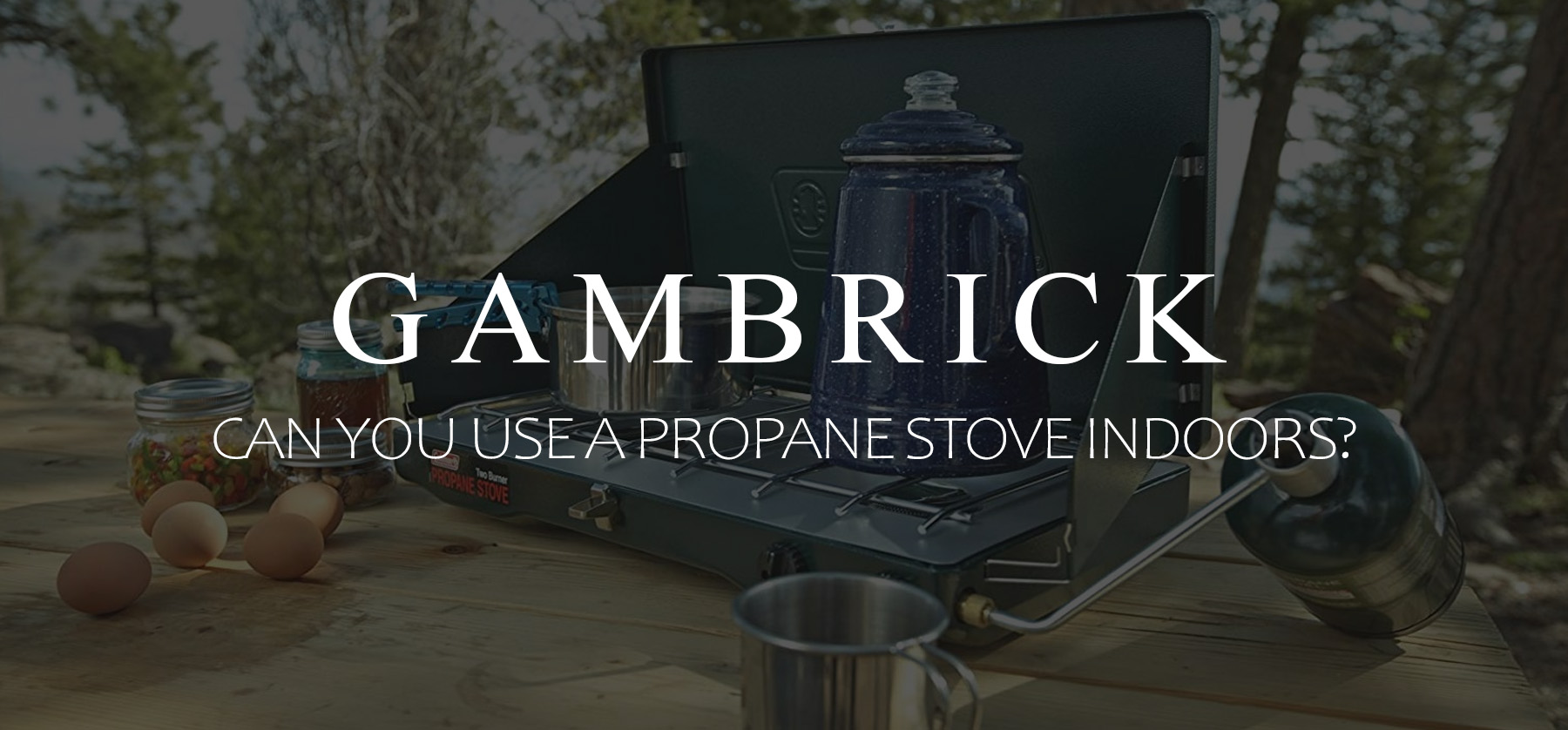Can You Use A Propane Stove Indoors?
Yes, it’s safe to use a propane stove indoors. However, there are a few safety precautions to consider first. Like any appliance with an open flame, propane stoves give off fumes when they burn. In this case the fuel being burnt is propane gas. These fumes can be harmful to your health and possibly fatal because they contain Carbon Monoxide (CO). Proper ventilation is very important because it removes harmful exhaust fumes from the house. Installing an overhead range hood above the propane stove is the best way to vent exhaust gases. You should also install a make-up air damper which brings in fresh air to replace the air you’re pumping out.
A range hood blower and make-up air damper blow exhaust fumes out of the house while sucking in fresh air. This ensures you have a steady stream of clean air to replace the fumes you pump out of the house.
If you don’t have room for a range hood and/or make-up air damper, open a window or two where you’re cooking. This helps circulate fresh air inside the home and allows exhaust fumes to be diluted and drawn outside. Installing a fan pointing outward is a big help because it’ll blows exhaust fumes out. Open another window across from the fan to create cross ventilation.
Using propane tanks indoors is another issue. It’s safe to use propane inside a home however you should never store the tanks inside. Store them outside in a cool dry place.
Is It safe To Use A Propane Stove Indoors?
Yes, it’s safe to use a propane stove indoors as long as you take the proper safety precautions. Propane stoves are designed to be used outdoors, so they can be dangerous when used indoors if you’re not careful. However, the steps you need to take in order to make them safe are fairly easy to do.
Adequate Ventilation
The most important thing to consider when using a propane stove indoors is adequate ventilation. A propane stove releases exhaust fumes into the air as a bi-product of burning propane for fuel. These fumes contain Carbon Monoxide and other harmful gasses which can be harmful to your health if breathed in.
The best way to vent exhaust fumes from the stove is a range hood. Place the propane under an overhead range hood with a blower that pumps fumes to the outside.
Don’t use a range hood that doesn’t vent to the outside. They’re not as effective at removing gasses from the air.
Whenever you pump air out of a house you need to replace it with fresh air from the outside. The best way to do it is with a make-up air damper.
Install a make-up air damper in the same room as the range hood. When you activate the hood, negative air pressure is created inside the room due to the lost air. A sensor inside the damper will activate which brings in fresh outside air.
The damper restores air pressure by replacing exhausted fumes with fresh air 1 to 1.
If you don’t have a range hood, open a window near the stove. It will bring in fresh air while diluting and pulling out exhaust fumes.
Use a window fan blowing outward to vent even more exhaust fumes.
Opening a window across from the fan will create cross ventilation.
Create airflow around your stove to reduce the chance of dangerous fumes building up. A propane camping stove is designed for the outdoors which is well ventilated. Create as much ventilation as you can by opening a window, turning on a fan and using a venting exhaust hood.
Not All Range Hoods Vent Outside
Be aware that not all range hoods vent to the outside. Some simply recycle the air and remove odors. But they don’t do a thing to reduce harmful CO fumes being exhausted into the air. If you use an outdoor propane stove indoors under a range hood, make sure the hood is actually venting exhaust gasses to the outside.
Once you’re sure the hood is venting gasses properly, open a window or install a make-up air damper to replace the vented air with fresh new air.
Install A CO Detector
Install a Carbon Monoxide (CO) detector by the propane stove. Outdoor propane stoves do not burn as clean as indoor ranges. When using an outdoor propane stove indoors, some CO will be produced. You can’t smell Carbon Monoxide so the alarm will go off if levels get too high. Without a detector you won’t have any way of knowing CO is building up in the house.
If you’re not properly ventilating the stove, Carbon Monoxide will start to build up which will trigger the alarm. This is an important safety elements because CO poisoning can be fatal.
Also consider installing a propane gas detector. It will detect gas leaking from the stove.
Inspect The Stove For Wear Or Damage
Before using a propane stove indoors, inspect it for wear and/or damage. Check the valves, controls, hoses, connection points, burners and fuel ports. If you find any issues, take care of them before using the stove inside.
There’s more room for error with an outdoor appliance compared to an inside one. So before using your propane stove indoors, make sure there are no issues that could leak gas or potentially cause a fire.
Store The Propane Tank Properly
When you use a propane stove indoors, make sure to detach the tank and bring it outside when you’re done. Don’t leave the propane tank attached after you’re done. And don;t store propane tanks indoors.
Store your propane tanks outdoors in a cool, dry place.
Do not store propane tanks anywhere hot or in direct sunlight.
Cook Fast Meals
Using an outdoor propane stove indoor is more dangerous than when using it outdoors. So try to cut down on time by cooking fast meals. The less amount of time the flame is on the less chance there is of accidents or CO buildup.
- Cook foods that require a quick pan fry like burgers, hot dogs or eggs so the flame doesn’t have to stay on for long.
- Stay away from dishes that require a long simmer.
- Use a cast iron skillet. Once you get it hot, it stays hot for longer which allows you to cook food even with the flame off.
Use A Small Propane Stove
The smaller the stove the less propane it burns. When using an outdoor propane stove indoors, you can limit the amount of potential leaks and CO buildup simply by using smaller stove. They don’t have as many burners and some don’t burn as hot so they use less gas. Less gas usage means a smaller tank and less chance of accidents or injury.
The Dangers Of Using A Propane Stove Indoors
Outdoor propane stoves function basically the same as domestic and commercial propane ranges found in many restaurants and homes. Propane comes in through a supply line and ignites at the burner. A knob controls the flow of propane from the tank to the burner. The more propane you feed the burner, the hotter the flame.
The major difference between an indoor and outdoor appliance is how often they’re designed to be used. Outdoor stoves are designed for occasional use. While indoor stoves are made for everyday cooking. For this reason, the build quality of an outdoor appliance is no where near an indoor one.
Even though an outdoor and indoor stove technically function in the same way, extra caution must be taken when using an outdoor propane stove indoors. This is because an outdoor stove is not built as well as an indoor propane range.
There are three main dangers associated with using propane: explosions, fire, and carbon monoxide poisoning.
Propane Gas Explodes
Propane tanks can explode if damaged or store incorrectly. This could cause damage to your home, personal injury and even death. Entire home’s have been leveled when large storage tanks have exploded, but even small camping tanks can cause serious damage.
However the risk of explosion is very low. Propane tanks are used daily all over the world and accidents are very rare. In some rural locations, propane is the primary source of energy used for cooking, heating and electricity.
Despite how rare a propane explosion is, you still need to be aware that it’s a potential danger. Especially if you plan on using a propane stove indoors.
To reduce the risk of explosion, do the following:
- Inspect the tanks for damage before using them indoors.
- Properly store the tanks in a cool dry place.
- Do not store propane tanks indoors.
- Don’t store propane tanks in a hot are or in direct sunlight.
- Never hit or damage the tanks intentionally.
- If a tank is damaged, don’t use it in your home.
Propane Is Flammable
Propane is highly flammable gas s there’s always a risk of fire whenever you use it. This is made even worse when you use a propane stove indoors. If a fire starts, it could potentially burn the entire home down causing injury or even death.
Using a propane stove indoors is riskier than using it outdoors. Especially if the stove is designed for outdoor use.
However, using propane as a fuel source is still very safe overall. But you always need to be very careful when cooking with it because the gas is highly flammable.
Here are some things you can do to reduce the risk of fire:
- Inspect the hose leading from the tank to the stove for leaks.
- Check the connection points for leaks.
- Make sure the tank itself isn’t leaking.
Carbon Monoxide (CO) Poisoning
When propane stoves burn with an incomplete combustion they produce more Carbon Monoxide (CO). An indoor propane range is generally a much higher quality appliance than a cheaper outdoor stove. This means they burn cleaner and produce less CO emissions when working properly.
- Carbon Monoxide (CO) is an odorless, colorless, and tasteless gas that’s poisonous to humans.
- Carbon monoxide poisoning is the leading cause of poisoning death. When you inhale too much CO, your cells aren’t able to get the oxygen they need to survive.
- Symptoms of CO poisoning include a dull headache, nausea, vomiting, blurred vision, weakness, dizziness, confusion, shortness of breath, and eventually loss of consciousness and death.
- CO poisoning is called the silent killer because it kills people while they sleep.
Because Carbon Monoxide (CO) poisoning is so dangerous and such a serious threat, you must install a Carbon Monoxide (CO) detector by the stove when you’re cooking. It will detect excessive amounts of CO being released by the stove. This is even more important when using an outdoor propane stove indoors because they don’t burn as clean as indoor ranges and produce more CO.
Make sure to have proper ventilation when using an outdoor propane stove indoors.
Here are the best ways to do it:
- Use a propane stove directly under a range hood that vents exhaust fumes outdoors.
- Install a make-up air damper to replace vented air with new fresh air 1 to 1.
- Open a window if you don’t have a range hood.
- Use a fan to blow air outward.
- Open a window across from the fan to create cross ventilation.
- Make sure the stove is turned off when not in use.
- Disconnect the propane tank when not using the stove to help prevent leaks.
How To Detect A Propane Leak
When you use an outdoor propane stove indoors, you have to be careful about leaking gas. Outdoor stoves are designed to be used outdoors which is more ventilated than a home could ever be. A gas leak is still bad outdoors, but not as bad as when it happens in your kitchen.
Before you start cooking, check the hoses, tank, burners and connection points for issues.
Here are a few ways you can detect a propane leak:
Smelling Rotten Eggs
Propane companies often add an odor to their propane which smells like rotten eggs. This is to make detecting leaks easier. If there’s a leak, you’ll smell rotten eggs faster than you would propane by itself. As soon as you detect the smell, turn off the gas and bring the stove outside.
Spikes In Propane Usage
If gas usage spikes even though you’re using a stove the same amount of time per day, week or month, the problem is usually a leak. This is something you’ll easily detect if you do a lot of cooking with your propane stove.
For example, I know my propane grill uses about one bar every time I cook with it. I have a stove with a meter that measures the weight of the tank telling me about how much propane I have left in the tank. If my usage spikes to 2 bars per cook I know something is wrong.
Being aware of how much propane you’re using and how fast is helpful to detect leaks if the manufacturer does not include the rotten egg smell.
Poor Performance From Your Propane Stove
If your propane stove is not operating at its regular strength, there’s a very good chance you’ve got a leak. A great way to test this out is by turning the flame on its lowest setting. If there’s a leak, you could have too little propane coming out of the burner to keep the flame lit. You’ll see it sputter and possibly go out.
If you suspect a leak, turn the burners off and disconnect the tank. Then inspect the tank, lines and connection points for issues.
A common area where propane stoves leak is where you connect the tank to the stove. Make sure you thread the hose properly and that there’s a tight seal.
The Benefits Of A Propane Stove
There are a few benefits that comes with using propane as a fuel for your stove:
- Propane is a relatively clean and environmentally friendly fuel that releases fewer pollutants into the atmosphere than other stove fuels.
- Unlike natural gas, since it’s stored on-site in a pressurized tank the user has the ability to shut off the flow of gas if there’s a leak.
- Propane is an efficient high-octane fuel which reaches cooking temperatures faster than other fuels.
- Because propane burns so efficiently, there’s less maintenance caused by carbon build-up due to unburned or partially burned fuel.
- Propane is a cost effective fuel source. It’s high efficiency uses less energy than a stove running on other fuel sources. You can also purchase propane when prices are low and store it.
- Almost 90% of all propane used is made in America.
- Propane is a versatile fuel. You can use a tank indoors to fuel a stove and then take it outdoors to power a grill, torch, generator or heater.
Summary: Can You Use A Propane Stove Indoors?
Yes, it’s safe to use a propane stove indoors. However, there are a few safety precautions to consider first. Like any appliance with an open flame, propane stoves give off fumes when they burn. In this case the fuel being burnt is propane gas. These fumes can be harmful to your health and possibly fatal because they contain Carbon Monoxide (CO). Proper ventilation is very important because it removes harmful exhaust fumes from the house. Installing an overhead range hood above the propane stove is the best way to vent exhaust gases. You should also install a make-up air damper which brings in fresh air to replace the air you’re pumping out.
A range hood blower and make-up air damper blow exhaust fumes out of the house while sucking in fresh air. This ensures you have a steady stream of clean air to replace the fumes you pump out of the house.
If you don’t have room for a range hood and/or make-up air damper, open a window or two where you’re cooking. This helps circulate fresh air inside the home and allows exhaust fumes to be diluted and drawn outside. Installing a fan pointing outward is a big help because it’ll blows exhaust fumes out. Open another window across from the fan to create cross ventilation.
Using propane tanks indoors is another issue. It’s safe to use propane inside a home however you should never store the tanks inside. Store them outside in a cool dry place.
If you have any questions about how to safely use a propane stove, email any time.





















